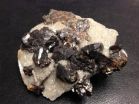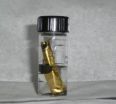(Press-News.org) TEMPE, Ariz. - Reactions among minerals and organic compounds in hydrothermal environments are critical components of the Earth's deep carbon cycle, they provide energy for the deep biosphere, and may have implications for the origins of life. However, very little is known about how minerals influence organic reactions. A team of researchers from Arizona State University have demonstrated how a common mineral acts as a catalysts for specific hydrothermal organic reactions – negating the need for toxic solvents or expensive reagents.
At the heart of organic chemistry, aka carbon chemistry, is the covalent carbon-hydrogen bond (C–H bond) ─ a fundamental link between carbon and hydrogen atoms found in nearly every organic compound.
The essential ingredients controlling chemical reactions of organic compounds in hydrothermal systems are the organic molecules, hot pressurized water, and minerals, but a mechanistic understanding of how minerals influence hydrothermal organic reactivity has been virtually nonexistent.
The ASU team set out to understand how different minerals affect hydrothermal organic reactions and found that a common sulfide mineral (ZnS, or Sphalerite) cleanly catalyzes a fundamental chemical reaction – the making and breaking of a C-H bond.
Their findings are published in the July 28 issue of the Proceedings of the National Academy of Sciences. The paper was written by a transdisciplinary team of ASU researchers that includes: Jessie Shipp (2013 PhD in Chemistry & Biochemistry), Ian Gould, Lynda Williams, Everett Shock, and Hilairy Hartnett. The work was funded by the National Science Foundation.
"Typically you wouldn't expect water and an organic hydrocarbon to react. If you place an alkane in water and add some mineral it's probably just going to sit there and do nothing," explains first author Shipp. "But at high temperature and pressure, water behaves more like an organic solvent, the thermodynamics of reactions change, and suddenly reactions that are impossible on the bench-top start becoming possible. And it's all using naturally occurring components at conditions that can be found in past and present hydrothermal systems."
A mineral in the mix
Previously, the team had found they could react organic molecules in hot pressurized water to produce many different types of products, but reactions were slow and conversions low. This work, however, shows that in the presence of sphalerite, hydrothermal reaction rates increased dramatically, the reaction approached equilibrium, and only one product formed. This very clean, very simple reaction was unexpected.
"We chose sphalerite because we had been working with iron sulfides and realized that we couldn't isolate the effects of iron from the effects of sulfur. So we tried a mineral with sulfur but not iron. Sphalerite is a common mineral in hydrothermal systems so it was a pretty good choice. We really didn't expect it to behave so differently from the iron sulfides," says Hartnett, an associate professor in the School of Earth and Space Exploration, and in the Department of Chemistry and Biochemistry at ASU.
This research provides information about exactly how the sphalerite mineral surface affects the breaking and making of the C-H bond. Sphalerite is present in marine hydrothermal systems i.e., black smokers, and has been the focus of recent origins-of-life investigations.
For their experiments, the team needed high pressures (1000 bar - nearly 1000 atm) and high temperatures (300°C) in a chemically inert container. To get these conditions, the reactants (sphalerite, water, and an organic molecule) are welded into a pure gold capsule and placed in a pressure vessel, inside a furnace. When an experiment is done, the gold capsule is frozen in liquid nitrogen to stop the reaction, opened and allowed to thaw while submerged in dichloromethane to extract the organic products.
"This research is a unique collaboration because Dr. Gould is an organic chemist and you combine him with Dr. Hartnett who studies carbon cycles and environmental geochemistry, Dr. Shock who thinks in terms of thermodynamics and about high temperature environments, and Dr. Williams who is the mineral expert, and you get a diverse set of brains thinking about the same problems," says Shipp.
Hydrothermal organic reactions affect the formation, degradation, and composition of petroleum, and provide energy and carbon sources for microbial communities in deep sedimentary systems. The results have implications for the carbon cycle, astrobiology, prebiotic organic chemistry, and perhaps even more importantly for Green Chemistry (a philosophy that encourages the design of products and processes that minimize the use and generation of hazardous substances).
"This C-H bond activation is a fundamental step that is ultimately necessary to produce more complex molecules – in the environment those molecules could be food for the deep biosphere – or involved in the production of petroleum fuels," says Hartnett. "The green chemistry side is potentially really cool – since we can conduct reactions in just hot water with a common mineral that ordinarily would require expensive or toxic catalysts or extremely harsh – acidic or oxidizing – conditions."
INFORMATION:
Mineral magic? Common mineral capable of making and breaking bonds
ASU team shows evidence for one mineral affecting the most fundamental process in organic chemistry: Carbon-hydrogen bond breaking and making
2014-07-28
ELSE PRESS RELEASES FROM THIS DATE:
Forced mutations doom HIV
2014-07-28
CAMBRIDGE, MA -- Fifteen years ago, MIT professor John Essigmann and colleagues from the University of Washington had a novel idea for an HIV drug. They thought if they could induce the virus to mutate uncontrollably, they could force it to weaken and eventually die out — a strategy that our immune system uses against many viruses.
The researchers developed such a drug, which caused HIV to mutate at an enhanced rate, as expected. But it did not eliminate the virus from patients in a small clinical trial reported in 2011. In a new study, however, Essigmann and colleagues ...
Tennessee Surgical Quality Collaborative saves 533 lives and $75 million in 3 years
2014-07-28
NEW YORK (July 28, 2:45 pm [ET]): Ten hospitals in the Tennessee Surgical Quality Collaborative (TSQC) have reduced surgical complications by 19.7 percent since 2009, resulting in at least 533 lives saved and $75.2 million in reduced costs, according to new results presented today at the American College of Surgeons National Surgical Quality Improvement Program (ACS NSQIP®) National Conference in New York City.
The hospital collaborative was formed in 2008 as a partnership of the Tennessee Chapter of the American College of Surgeons and the Tennessee Hospital Association's ...
Stimulation of brain region restores consciousness to animals under general anesthesia
2014-07-28
Stimulating one of two dopamine-producing regions in the brain was able to arouse animals receiving general anesthesia with either isoflurane or propofol. In the August issue of Anesthesiology, investigators from Massachusetts General Hospital (MGH) report that rats anesthetized with continuous doses of either agent would move, raise their heads and even stand up in response to electrical stimulation delivered to the ventral tegmental area (VTA). Stimulation of the other major dopamine-releasing area, the substantia nigra, did not induce the animals to wake up.
"Dopamine ...
Study suggests disruptive effects of anesthesia on brain cell connections are temporary
2014-07-28
A study of juvenile rat brain cells suggests that the effects of a commonly used anesthetic drug on the connections between brain cells are temporary.
The study, published in this week's issue of the journal PLOS ONE, was conducted by biologists at the University of California, San Diego and Weill Cornell Medical College in New York in response to concerns, arising from multiple studies on humans over the past decade, that exposing children to general anesthetics may increase their susceptibility to long-term cognitive and behavioral deficits, such as learning disabilities.
An ...
UTSW cancer researchers identify irreversible inhibitor for KRAS gene mutation
2014-07-28
DALLAS – July 28, 2014 – UT Southwestern Medical Center cancer researchers have found a molecule that selectively and irreversibly interferes with the activity of a mutated cancer gene common in 30 percent of tumors.
The molecule, SML-8-73-1 (SML), interferes with the KRAS gene, or Kirsten rat sarcoma viral oncogene homolog. The gene produces proteins called K-Ras that influence when cells divide. Mutations in K-Ras can result in normal cells dividing uncontrollably and turning cancerous. These mutations are particularly found in cancers of the lung, pancreas, and colon. ...
Stress-tolerant tomato relative sequenced
2014-07-28
The genome of Solanum pennellii, a wild relative of the domestic tomato, has been published by an international group of researchers including the labs headed by Professors Neelima Sinha and Julin Maloof at the UC Davis Department of Plant Biology. The new genome information may help breeders produce tastier, more stress-tolerant tomatoes.
The work, published July 27 in the journal Nature Genetics, was lead by Björn Usadel and colleagues at Aachen University in Germany. The UC Davis labs carried out work on the transcriptome of S. pennellii — the RNA molecules that are ...
Researchers discover cool-burning flames in space, could lead to better engines on earth
2014-07-28
A team of international researchers has discovered a new type of cool burning flames that could lead to cleaner, more efficient engines for cars. The discovery was made during a series of experiments on the International Space Station by a team led by Forman Williams, a professor of mechanical and aerospace engineering at the University of California, San Diego. Researchers detailed their findings recently in the journal Microgravity Science and Technology.
"We observed something that we didn't think could exist," Williams said.
A better understanding of the cool flames' ...
HIV research findings made possible by a test developed at CU School of Pharmacy
2014-07-28
HIV research findings made possible by a test developed at University of Colorado Skaggs School of Pharmacy and Pharmaceutical Sciences (CU School of Pharmacy)
AURORA, Colo (July 28, 2014) An influential new test, discovered and developed in the Colorado Antiviral Pharmacology Laboratory at the CU School of Pharmacy, helps monitor the effectiveness of the HIV prevention drug called Truvada (a combination of tenofovir/emtricitabine), which is taken once daily to prevent HIV infection.
A study presented during the AIDS 2014 Conference and published in Lancet Infectious ...
NASA sees Tropical Storm Hernan near Mexico's Baja California
2014-07-28
Tropical Storm Hernan developed over this past weekend and reached hurricane strength before vertical wind shear kicked in and kicked the storm down. NASA's Terra satellite passed over Hernan when it was developing as a tropical depression near Baja California, Mexico.
Tropical Storm Hernan was born on Saturday, July 26 at 5 a.m. EDT as Tropical Depression 8-E. By 5 p.m. EDT it strengthened into Tropical Storm Hernan. At 11 a.m. EDT on Sunday, July 27, Hernan's maximum sustained winds were already up to 70 mph, just four miles per hour shy of hurricane status. As Hernan ...
NOAA: 'Nuisance flooding' an increasing problem as coastal sea levels rise
2014-07-28
Eight of the top 10 U.S. cities that have seen an increase in so-called "nuisance flooding"--which causes such public inconveniences as frequent road closures, overwhelmed storm drains and compromised infrastructure--are on the East Coast, according to a new NOAA technical report.
This nuisance flooding, caused by rising sea levels, has increased on all three U.S. coasts, between 300 and 925 percent since the 1960s.
The report, Sea Level Rise and Nuisance Flood Frequency Changes around the United States, also finds Annapolis and Baltimore, Maryland, lead the list with ...
LAST 30 PRESS RELEASES:
Numbers in our sights affect how we perceive space
SIMJ announces global collaborative book project in commemoration of its 75th anniversary
Air pollution exposure and birth weight
Obstructive sleep apnea risk and mental health conditions among older adults
How talking slows eye movements behind the wheel
The Ceramic Society of Japan’s Oxoate Ceramics Research Association launches new international book project
Heart-brain connection: international study reveals the role of the vagus nerve in keeping the heart young
Researchers identify Rb1 as a predictive biomarker for a new therapeutic strategy in some breast cancers
Survey reveals ethical gaps slowing AI adoption in pediatric surgery
Stimulant ADHD medications work differently than thought
AI overestimates how smart people are, according to HSE economists
HSE researchers create genome-wide map of quadruplexes
Scientists boost cell "powerhouses" to burn more calories
Automatic label checking: The missing step in making reliable medical AI
Low daily alcohol intake linked to 50% heightened mouth cancer risk in India
American Meteorological Society announces Rick Spinrad as 2026 President-Elect
Biomass-based carbon capture spotlighted in newly released global climate webinar recording
Illuminating invisible nano pollutants: advanced bioimaging tracks the full journey of emerging nanoscale contaminants in living systems
How does age affect recovery from spinal cord injury?
Novel AI tool offers prognosis for patients with head and neck cancer
Fathers’ microplastic exposure tied to their children’s metabolic problems
Research validates laboratory model for studying high-grade serous ovarian cancer
SIR 2026 delivers transformative breakthroughs in minimally invasive medicine to improve patient care
Stem Cell Reports most downloaded papers of 2025 highlight the breadth and impact of stem cell research
Oxford-led study estimates NHS spends around 3% of its primary and secondary care budget on the health impacts of heat and cold in England
A researcher’s long quest leads to a smart composite breakthrough
Urban wild bees act as “microbial sensors” of city health.
New study finds where you live affects recovery after a hip fracture
Forecasting the impact of fully automated vehicle adoption on US road traffic injuries
Alcohol-related hospitalizations from 2016 to 2022
[Press-News.org] Mineral magic? Common mineral capable of making and breaking bondsASU team shows evidence for one mineral affecting the most fundamental process in organic chemistry: Carbon-hydrogen bond breaking and making






